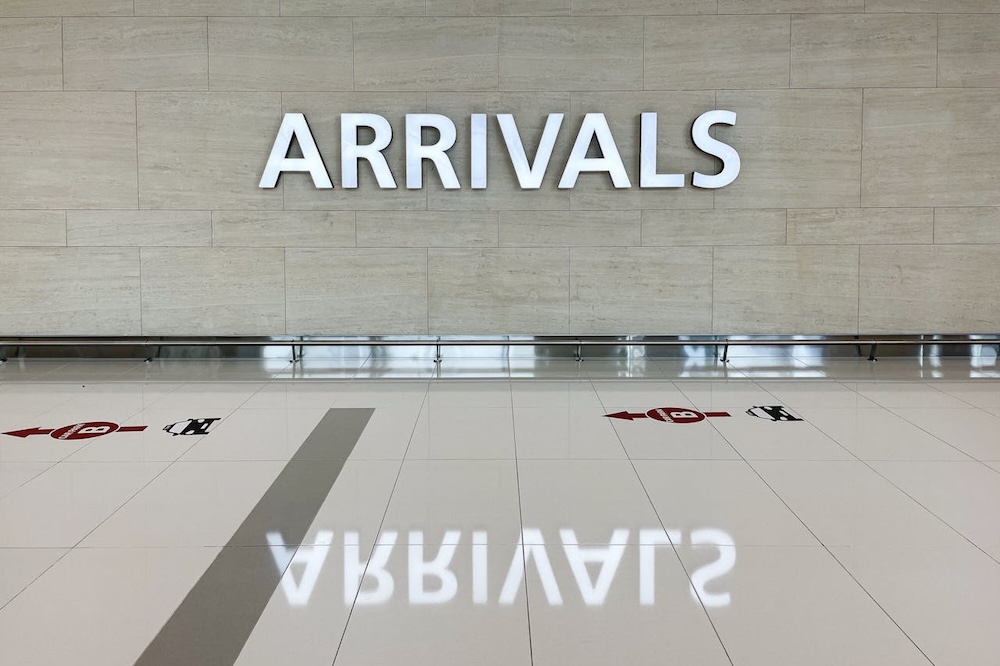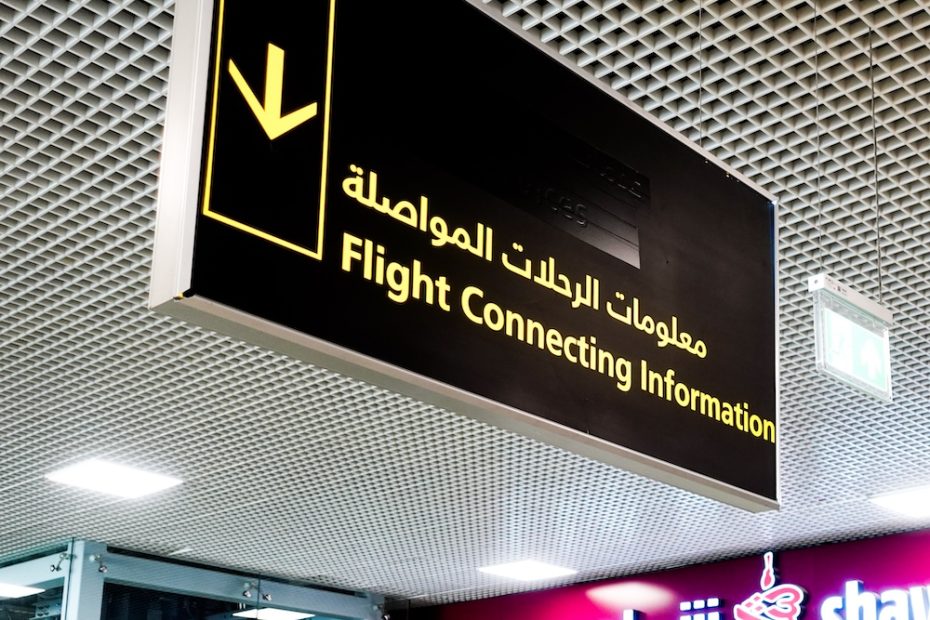Flying direct is convenient, but it’s not always an option.
Sometimes, it’s much more expensive than taking a connecting flight. Other times, a direct flight just isn’t available, so you have to opt for a connecting one. What exactly is a connecting flight? What are the key differences between self-transfer and airline transfer (regular connecting flight)? How do connecting flights work? These are the questions we will answer in this informative article.
Was your connecting flight delayed or cancelled? You might be eligible for compensation.
In Europe, you could get up to 600 euros for a bad flight.
Check flight compensation online.
Connecting Flights: FAQ
1. What Is a Connecting Flight?
A connecting flight involves two or more flights.
Simply put, it means you need to change planes. You won’t fly directly from A to B; instead, you’ll fly from A to C, then C to B. Often there are multiple stops, and more than 2 flight legs. The wait at the airport between flights is called a layover.
If a layover is longer than 24 hours, it’s called a stopover.
Often a connecting flight is the only option because there are no direct flights.
2. Connecting Flight Types: Airline Transfer vs Self Transfer
There are two connecting flight types.
An airline transfer, or regular connecting flight, is organized by the airline.
When you book such a connecting flight, it’s on a single booking – all flights are on one ticket. This means the airline takes responsibility for getting you and your luggage from one plane to another. Your boarding passes for all legs of your journey are typically issued at check-in, and your luggage is checked through to your final destination.
If you miss your connection due to a delay or cancellation on the first leg of your trip, the airline provides assistance and support and is responsible for rebooking you on the next available flight. While you wait for your next flight, you are entitled to care from the airline.
What is a self-transfer flight?
What does self-transfer mean on Skyscanner?
In contrast, a self-transfer flight involves booking separate flights independently. These flights are unconnected, even if they’re with the same airline. This means you’ll need to handle your luggage (collecting and rechecking it), check in again, and go through security and passport control at the connecting airport. If you miss a connection, you may have to purchase a new ticket for the next leg of your journey.
Self-transfers can provide flexibility and cost savings, but they also carry more risk and responsibility.
Certain self-transfers can have protection through a third-party service. For instance, individual flights booked through kiwi.com can be safeguarded under the Kiwi Guarantee if you opt for it.
3. Do Low-Cost Airlines Offer Connecting Flights?
Some low-cost airlines provide connecting flights.
Connecting flights on low-cost airlines operate similarly to those on traditional airlines: during check-in, you get all boarding passes, your luggage is checked through to your final stop, and you remain in the transit area without having to pass through passport control.
Here are some examples of low-cost airlines that sell connecting flights.
- Norwegian Air Shuttle – a low-cost airline based in Norway that offers flights within Europe, to Turkey, and to a few North African countries.
- Vueling – a budget airline from Spain that flies within Europe.
- Pegasus Airlines – a budget airline from Turkey operating flights to Europe, the Middle East and Asia.
- Scoot – a Singaporean low-cost airline that flies within Asia and also offers a few long-distance routes to Europe.
- Air Asia – a Malaysian multinational low-cost airline, one of the best low-cost airlines in the world. It operates a vast flight network in Asia and also serves routes to Australia, the Middle East, and Central Asia.
Check flight compensation online.

4. How Do Connecting Flights Work?
It depends on what type of connecting flight you have.
If you have a regular connecting flight (airline transfer), the procedure for connecting flights is very easy. When checking in your luggage, it will usually be checked through to your final stop. Also, you will receive all boarding passes at the check-in counter. You won’t need to check in for your flights again.
At the connecting airport, just go to your next gate and wait for your next flight. There might be a security check at the connecting airport, but you don’t need to worry about your luggage—airport personnel will handle it. You won’t need to go through passport control since you will stay in the transit area.
Is a transit visa required for connecting flights? For regular connecting flights, no transit visa is needed. You’ll be in the transit area for connecting passengers; no passport control is required.
If you have booked your flights separately (self-transfer), the process is different.
You will likely need to handle your luggage on your own.
Additionally, you might have to enter the country you’re transiting through, which could require a visa—even if you’re just collecting your luggage for the next flight. So, always check the visa rules before booking your flight. If you haven’t checked in online, you will need to check in for your flights at each airport.
5. What to Do if You Miss Your Connecting Flight?
For a regular connecting flight with a traditional airline (some budget airlines offer them too), you’re covered if you miss it due to a delay or cancellation of the first flight.
The airline will help and book a new free flight to your destination, including transferring your baggage. Also, you have a right to care while you wait for your new flight.
If you have a self-transfer (you have booked your flights separately), and, let’s say, your first flight gets heavily delayed or cancelled at the last minute, you can’t make it to the next flight. In situations like these, it’s going to be your responsibility to buy yourself a new flight. The airline/airlines you are flying with are not responsible for your missed connections.
However, you may still be entitled to flight delay compensation or flight cancellation compensation for that first disrupted flight. But not for the whole journey. Travel insurance that covers such cases might help you in situations when you miss your next flight.
When booking a self-transfer flight, ensure there’s ample time between flights. You’ll need time for passport control, collecting and rechecking baggage, checking in separately for each flight (you can do this online as well), and going through security again. Allow several hours between flights for a smoother experience.
6. Missed Connecting Flight Compensation
If you miss your connecting flight due to a delay or cancellation of the previous flight, and it’s a protected airline transfer, you could receive compensation for the missed flight.
However, it’s not termed “missed connecting flight compensation,” but a standard flight delay compensation. The amount of compensation is based on the flight distance.
If it’s a single flight, it’s simple – just the distance of that flight.
With a connecting flight, you calculate based on the entire journey. If you have a connecting flight from Budapest – to Warsaw – to Seoul, and you arrive in Seoul with a delay of several hours, you may get 600 euros, even if it’s the first flight that was delayed.
Your first flight was delayed, and because of that, you missed the second (long-distance) flight. That resulted in late arrival to your final destination. It counts as a flight delay, and you can get flight delay compensation of 600 euros for the whole journey.
If you have a self-transfer flight, you have to consider each flight leg as a separate flight. Since they aren’t booked under one reference number, missing a connecting flight due to delay/cancellation won’t entitle you to compensation for the entire journey, only for the disrupted flight.
Yes, you can get compensation for separate flights. See, for example, our guide on Wizz Air flight delay compensation. These rules are similar with most airlines in Europe, and not only.
If you have two separate flights: Budapest – Warsaw and Warsaw – Seoul, and the first one is delayed making you miss your long-distance flight to Seoul, you may be entitled to compensation only for the first disrupted flight, not for the whole journey. As the first flight is very short (only about 600 km), you may be entitled to the smallest compensation of 250 euros. In addition to that, you won’t be entitled to a new flight to your destination. Remember, with self-transfer flights, you’re responsible for getting to your next flight on time.
Read more: How Much Is Flight Compensation in Europe?
Check flight compensation online.

7. Connecting Flight With Different Airlines: Codeshare vs Self-Transfer
If you have a connecting flight involving different airlines, there are two types: a traditional connecting flight operated by partner airlines (codeshare agreement), and a self-transfer where you handle the connection independently.
The key distinction is that self-transfer isn’t covered by the airlines, as it’s self-arranged. In contrast, a regular connecting flight is protected by partner airlines involved in the operation. If you have a regular connecting flight with different airlines it works the same as connecting flights with the same airline.
7.1 Connecting Flight With Different Airlines – Baggage
If you have a connecting flight with different airlines, your baggage will be sent to your final destination. However, for self-transfers, you must collect and recheck your baggage.
7.2 Missed Connecting Flight – Different Airlines
If you miss your connecting flight operated by a partner airline, you will be booked on a new flight free of charge, just as you would if it was a connecting flight with the same airline. The airlines you are travelling with are partner airlines on a codeshare agreement. You booked your connecting flight under one booking reference number, so your connection is protected.
If it’s a self-transfer, you’re responsible for getting to your next flight on time.
You won’t get any assistance if you miss your next flight. Airlines on your self-transfer flight are not affiliated (i.e., are not partners). You arranged and made the connection independently.
8. How to Book Connecting Flights?
Booking connecting flights is easy unless it’s a self-transfer.
You can book traditional connecting flights directly from the airline or use services like Kiwi, Expedia, or eDreams. Simply select your starting point and destination, pick your dates and number of travellers, and then hit “Search.” Once you find the best choice, hit “Book”, input your details, and pay for the flight.
Pay attention to confirm if these are indeed standard connecting flights (airline-protected transfers). If they’re not, this information is typically indicated somewhere. If you need to switch airports during the journey, it’s usually a clear indication that these are not airline-protected transfers.
How to book self-transfer flights?
One of the options is to book flights one by one. This typically means searching for multiple flight choices, and comparing for the best one – considering cost, layover times, airport changes, etc. It can be time-consuming to find the optimal choice. When booking a self-transfer flight, ensure you have ample time between flights and try to avoid changing airports.
Another choice is to use third-party services like eDreams or Kiwi for self-transfer flights. These services offer both regular connecting flights and combine separate flights to create a self-transfer connection. You purchase the flights as a single package instead of booking each flight separately. However, even though they come as a package, these flights are considered self-transfers and do not offer the same level of protection as traditional connecting flights.
If you are booking your self-transfer from kiwi.com, it can be safeguarded under the Kiwi Guarantee if you opt for it.
9. Baggage on Connecting Flights
What happens to your luggage during a connecting flight?
It depends on the connecting flight type.
If you are travelling on a single ticket (regular connecting flight), your bags will usually be checked through to your final destination. If unsure, ask the check-in agent.
If you have a self-transfer (separate flights), you’ll need to pick up and recheck your luggage at the transfer point.
Always pack a change of clothes in your carry-on bag or personal item. This way, if your checked luggage gets lost, you’ll have something to change into.
Do you have more questions about connecting flights and self-transfer flights? Feel free to ask in the comments.
